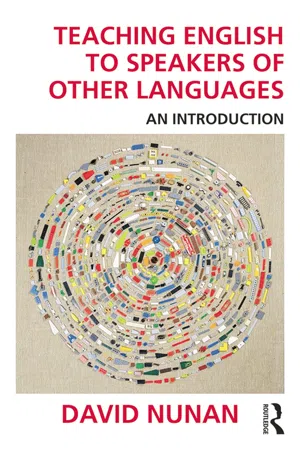
- 204 pages
- English
- ePUB (mobile friendly)
- Available on iOS & Android
About this book
David Nunan's dynamic learner-centered teaching style has informed and inspired countless TESOL educators around the world. In this fresh, straightforward introduction to teaching English to speakers of other languages he presents teaching techniques and procedures along with the underlying theory and principles.
Complex theories and research studies are explained in a clear and comprehensible, yet non-trivial, manner without trivializing them. Practical examples of how to develop teaching materials and tasks from sound principles provide rich illustrations of theoretical constructs. The content is presented through a lively variety of different textual genres including classroom vignettes showing language teaching in action, question and answer sessions, and opportunities to 'eavesdrop' on small group discussions among teachers and teachers in preparation. Readers get involved through engaging, interactive pedagogical features and opportunities for reflection and personal application. Each chapter follows the same format so that readers know what to expect as they work through the text. Key terms are defined in a Glossary at the end of the book. David Nunan's own reflections and commentaries throughout enrich the direct, up-close style of the text.
Frequently asked questions
- Essential is ideal for learners and professionals who enjoy exploring a wide range of subjects. Access the Essential Library with 800,000+ trusted titles and best-sellers across business, personal growth, and the humanities. Includes unlimited reading time and Standard Read Aloud voice.
- Complete: Perfect for advanced learners and researchers needing full, unrestricted access. Unlock 1.4M+ books across hundreds of subjects, including academic and specialized titles. The Complete Plan also includes advanced features like Premium Read Aloud and Research Assistant.
Please note we cannot support devices running on iOS 13 and Android 7 or earlier. Learn more about using the app.
Information
1 LANGUAGE TEACHING METHODOLOGY
Goals
- define the following key terms – curriculum, syllabus, methodology, evaluation, audiolingualism, communicative language teaching, task-based language teaching, grammar-translation, structural linguistics
- describe the ‘eclectic’ method in which a teacher combines elements of two or more teaching methods or approaches
- set out the essential issues underpinning the methods debate
- articulate three key principles that guide your own approach to language teaching methodology
- say how communicative language teaching and task-based language teaching are related
- describe the three-part instructional cycle of pre-task, task, and follow-up
Introduction

Vignette
- What 3 things did you notice in the vignette? Write them down in note form.

- Write down 3–5 questions you would like to ask the teacher about the lesson.
My Observations on the Vignette
- The teacher begins the lesson with a classic audiolingual drill. This is the way that I was trained to teach languages back in the early 1970s. Despite her relative inexperience, the young teacher has confidence because the rigid set of procedures laid out in the audiolingual methodology gives her control of the classroom.
- The teacher is active. She encourages the students with positive feedback, but also gives gentle correction when they make mistakes. She praises the students without being patronizing. This appears to create a positive classroom environment.
- In the second phase of the lesson, the teacher uses a technique from communicative language teaching (CLT)/task-based language teaching (TBLT). In my 2004 book on task-based language teaching I called this kind of classroom procedure a “communicative activity” (Nunan, 2004). It is partly a traditional grammar exercise (the students are practicing the grammar structure for the lesson “Is this your/Are these your …?), but it has an aspect of genuine communication. The student asking the question doesn’t know the answer prior to hearing the response from the person who is answering it.
Issue in Focus: The ‘Methods' Debate
Grammar-Translation
Audiolingualism
In the United States, in the 1960s, language teaching was under the sway of a powerful method – the Audiolingual Method. Stern (1974: 63) describes the period from 1958 to 1966 as the “Golden Age of Audiolingualism.” This drew on the work of American Structural Linguistics, which provided the basis for a grammatical syllabus and a teaching approach that drew heavily on the theory of behaviorism. Language learning was thought to depend on habits that could be established by repetition. The linguist Bloomfield (1942: 12) had earlier stated a principle that became a core tenet of audiolingualism_ “Language learning is overlearning: anything less is of no use.” Teaching techniques made use of repetition of dialogues and pattern practice as a basis for automatization followed by exercises that involved transferring learned patterns to new situations.(Richards, 2001: 25–26)
Communicative Language Teaching
Communicative language teaching (CLT) is an approach to language teaching that emphasizes learning a language first and foremost for the purpose of communicating with others. Communication includes finding out about what people did on the weekend … or on their last vacation and learning about classmates’ interests, activities, preferences and opinions and conveying one’s own. It may also involve explaining daily routines t...
Table of contents
- Cover Page
- Half-Title Page
- Title Page
- Copyright Page
- Table of Contents
- Introduction
- 1 Language Teaching Methodology
- 2 Learner-Centered Language Teaching
- 3 Listening
- 4 Speaking
- 5 Reading
- 6 Writing
- 7 Pronunciation
- 8 Vocabulary
- 9 Grammar
- 10 Discourse
- 11 Learning Styles and Strategies
- 12 Assessment
- Glossary
- Index